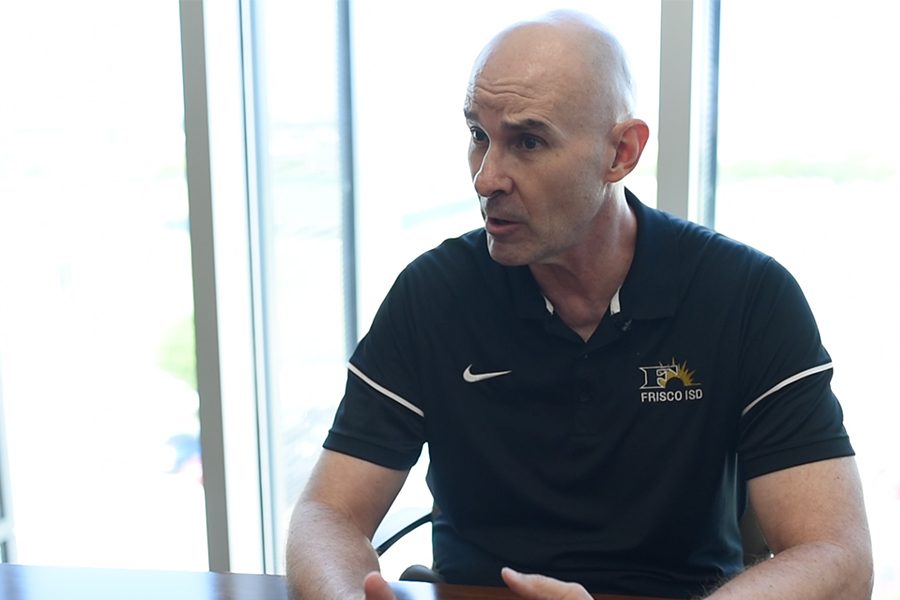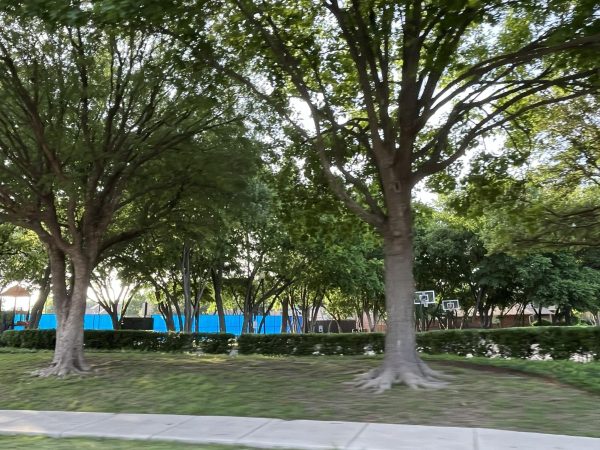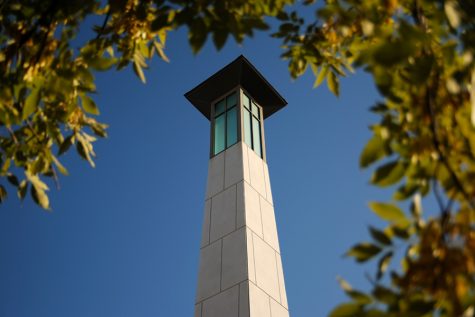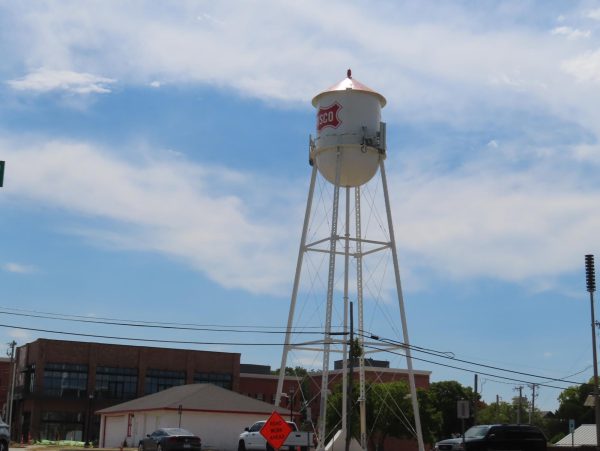Waldrip speaks on state of the school district
From video doorbells to high school #11, Wingspan sitFrisco ISD is an ever growing district with new plans constantly in play, and WIngspan was able to sit down with the man who runs it all. Here is part one of a special interview with Dr. Mike Waldrip.
Embarking on his third year leading Frisco ISD, superintendent Dr. Mike Waldrip leads a district of more than 60,000 students and 72 schools. Wingspan sat down with Waldrip on Tuesday for an exclusive interview on the state of the district and his vision for the future.
Wingspan: What would you say the status of Frisco ISD is with the 2019-2020 school year just having started?
Waldrip: “We have actually exceeded our October projection number on student enrollment, we just went over 62,000 students. That was our October projection, and we usually get an influx of students right after this Labor Day weekend, so we’ve been off to a really good start, but I think we’re expecting probably a significant number of additional students. All that being said, we’ve got plenty of room to handle all those students.”
Wingspan: What are the district’s biggest strengths? What are you still trying to improve?
Waldrip: “Well, I think our biggest strengths are our people. Obviously, we have a good school district because we have good teachers, good people in leadership roles in which we have a lot of community of parent’s support for our school district, and a really great partnership with the city as well. We’ve always had a good partnership with the city, and I think all those things kind of rolled into one big thing make Frisco kind of unique.”
Wingspan: Is high school number 11 still scheduled to open in 2021? What’s the long term forecast for how many high schools the district will have?
“It is scheduled to open in 2021. If you drive by the site right now, you can actually see they’ve started. I call it moving dirt. It’s about a two year process to build a high school, to build one of our high schools. They just started last month moving dirt and doing the dirt work. If you go by, there’s a big fence around the side, lots of equipment, [and people] doing things out there. They’re doing stuff to get ready. So you’ll see probably on a weekly basis, you’ll see things change on that site, and then for 2022 we plan on opening high school 12 in the Hollyhock subdivision right next to the new PGA golf course. Both those things are scheduled open in 2021 and 2022.”
Wingspan: We have had a bit of a break in major attendance rezoning. When do you think the next round of that will happen?
Waldrip: “Actually I don’t think anyone looks forward to rezoning, but obviously, when we get growth is certain areas of the district and the campuses start to fill up, we have to do something. Something that’s changing in Frisco that’s a little bit unique, is in the past, when we were a small district, and we were getting larger and larger and growing as a community, schools would fill up and then we would open a new school and transfer students into those new schools. There’s still some of that going on, but one of the things we’re experiencing now is the demographics change across the district and one campus will start to go down in enrollment a little bit when another campus is increasing. We’re actually starting to balance student enrollment between existing campuses, which is something we haven’t done a lot of, but is something we’ll be doing a lot more of in the future.”
Wingspan: Frisco and its surrounding area continue to be an attractive market for business relocations. One of the biggest of the recent announcements was the PGA coming to the city. How does the district and its students benefit from moves such as this and the Dallas Cowboys and the Ford Center?
Waldrip: “We have several district partnerships with a lot of sports organizations, obviously, the Dallas Cowboys is one. We have an agreement with the Dallas Stars, with the Frisco Roughriders, with FC Dallas, and now with the PGA. In addition to those things, we have partnerships with Baylor Scott and White hospital, and a number of other entities in our in our community and in the surrounding area. What that does, is it affords our students a lot of opportunity because we have programs like ISM, our independent study mentorship program, and the INCubatoredu program. We ask those leads leaders, and individuals that are out in the private sector to come in and work with our students, to mentor our students. They actually benefit significantly from that because they have a knowledge of things that perhaps our teaching staff doesn’t have. For example, the INCubatoredu program teaches lean startup. We bring actual people in from the business sector, to teach that course to our students and teach them lean startup methods: how to develop a business idea and then pitch it to investors. We benefit significantly from all those business partnerships in our community.”
Wingspan: 2019 saw the Texas state legislature make some moves on school finance and property tax reform. How does Frisco ISD think the state handled this and what more needs to be done?
Waldrip: “Well, the House Bill 3 was the biggest piece of finance legislation, and it made some significant changes in school finance in the state of Texas. Not every school district was affected in the same way. Some benefited more than others, and Frisco happened to be one of those school districts that did benefit significantly from House Bill 3. So as far as Frisco ISD is concerned, it’s a really good piece of legislation. I think every school district, with the exception of a few, had some benefit from House Bill 3. There were some pretty significant changes that were good for our school district.”
Wingspan: One of the outcomes of all this was the ability for the district to provide raises to teachers and staff. Why is this important to do?
Waldrip: “You want to attract the best staff for our students, and we want to retain that staff. We’re in a very competitive area for teachers and administrators, and actually every position, right down to bus drivers in our school district, and we try to maintain a very competitive salary and benefits structure for our employees so that we can attract the best and brightest, and we can retain those, because we know we have good teachers, and we have good support staff, and all those things are in place, that it benefits our students a great deal.”
Wingspan: A pilot program was launched in the district to install “video doorbells” at some elementary schools, how is this working and what is the future of this program?
Waldrip: “The way the doorbell system works is the front doors have a magnetic lock system on them, so you can’t enter this, you can’t just walk up to an elementary school and walk in the door. Now, what you have to do is, there’s a doorbell camera [you ring]; it’s a lot like a Ring doorbell. You walk up to that camera, and there’s a microphone, you’re in communication with the receptionist: it’s in the building, they ask you to show their ID. When you see the ID and you know who the person is, then they release the magnetic lock system and allow the person to come into the vestibule. They’re still not into the school, but now they’re allowed into the office area, so it’s a security feature that we put in our elementary schools, just to beef up that particular aspect of the people in the flow in and out of the building.”
Wingspan: Going inside the classroom now, the district scored above the state average in all STAAR exams and EOCs. What does this say about the work teachers and students are doing?
Waldrip: “I think that’s one aspect of what we do, and of course, we have a state accountability system that gives us a grade, and the school district as a whole did very well on that, but I don’t think that defines Frisco ISD. I think there’s so much more to what we do, and we’re actually working on a community based accountability system, where we’re engaging our community and asking them: what do you want to know about our school district? What would give you the information you need to let you know as a community member and a parent that we’re doing a good job with your students? It’s more than just the grade that we get from the state of Texas for how we did on on the STAAR test. So much more than that. As we develop that system, I think what we’ll find is that we’re communicating a whole lot more information about all the great things we’re doing that goes above and beyond a letter grade as assigned by the state of Texas.”
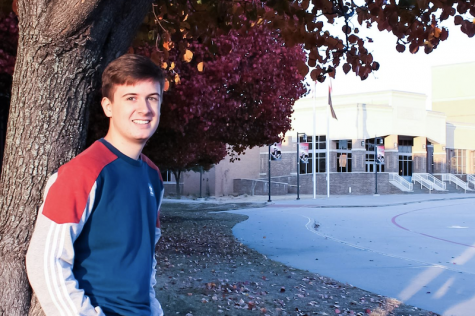
Lucas is a senior in his fourth year of Wingspan. As vice-president of Youth and Government on campus and at the Plano YMCA, he helps teach members bill-writing...



